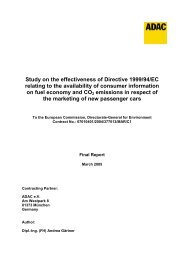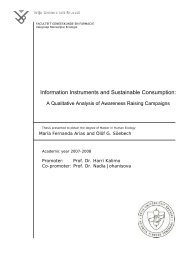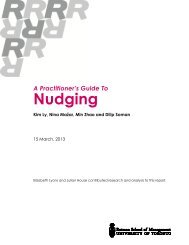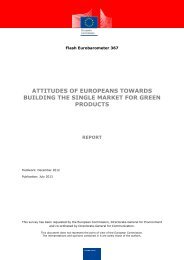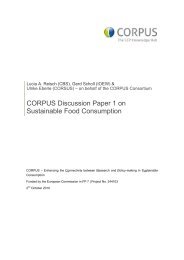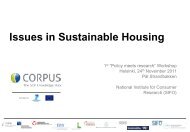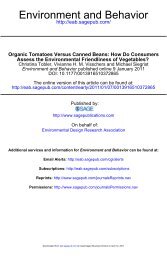Introducing behaviour changes towards sustainable food consumption
Introducing behaviour changes towards sustainable food consumption
Introducing behaviour changes towards sustainable food consumption
Create successful ePaper yourself
Turn your PDF publications into a flip-book with our unique Google optimized e-Paper software.
INTRODUCING BEHAVIOUR CHANGES<br />
Defra´s research indicates that adopting a low-impact diet is unpopular with most people, and that<br />
reducing dairy <strong>consumption</strong> is even less popular than eating less meat; there are strong habits, values<br />
and social norms around consuming animal products. It is easier to change people’s purchasing<br />
habits than their diets; reducing <strong>food</strong> waste and buying more seasonal and local <strong>food</strong> is generally a<br />
more acceptable goal than eating a low-impact diet. People are eating out more; interventions need<br />
to address <strong>sustainable</strong> eating at restaurants as well as in the home.<br />
How can <strong>behaviour</strong> be changed?<br />
Consumers need more than information in order to change their <strong>behaviour</strong> – <strong>sustainable</strong> choices can<br />
be promoted through infrastructure and pricing policies, as well as promoting social norms that make<br />
<strong>sustainable</strong> choices normal and desirable for mainstream society.<br />
Studying past successes in promoting <strong>sustainable</strong> <strong>behaviour</strong> (e.g. NCC and SDC 2006) shows that<br />
green consumers on their own are rarely able to change mainstream product markets – choice editing<br />
by regulators, retailers and manufacturers has driven the change in most cases.<br />
Make it realistic for people to change:<br />
• Remove barriers to <strong>sustainable</strong> <strong>behaviour</strong>: governments (and businesses) can ensure that prices<br />
are affordable, products are easily available, and that information is simple and clear.<br />
• Use choice-editing: the process of removing the least <strong>sustainable</strong> products from the market place,<br />
so that consumers are left to choose from a range of more <strong>sustainable</strong> products. For example,<br />
governments can ban damaging products or ingredients (e.g. inefficient light bulbs), or enforce<br />
minimum standards for products (e.g. efficiency standards for washing machines); businesses can<br />
choose to not stock the least <strong>sustainable</strong> products (e.g. fish that are listed as endangered species).<br />
This approach ensures that the responsibility for achieving <strong>sustainable</strong> <strong>consumption</strong> is not<br />
entirely borne by consumers.<br />
Target groups / communities rather than individuals:<br />
• People act, learn and change as part of their social groups rather than as individuals: changing<br />
what is socially acceptable (e.g. by targeting workplaces, schools, etc) makes it easier for people<br />
to adopt new <strong>behaviour</strong>s.<br />
• When acting as part of a group, people are reassured that their actions will make a difference.<br />
• Community-based social marketing can be effective at changing <strong>behaviour</strong>, through removing<br />
barriers to change (practical and social) and highlighting the benefits.<br />
Target more effectively:<br />
• Different people respond to different messengers, so a range of messengers is required e.g.<br />
governments, businesses, charities, media.<br />
• Using consumer segmentation models (see e.g. Defra 2008) may help with selecting appropriate<br />
interventions for various target audiences.<br />
• Clarify confusing issues, such as the over-focus on “<strong>food</strong> miles” (the impact of production, storage<br />
or domestic transport may be more significant, depending on the product).<br />
Page 2



